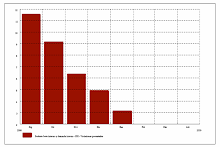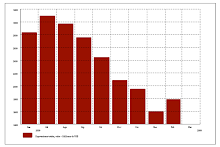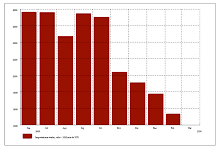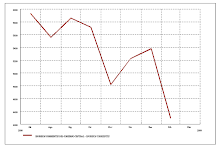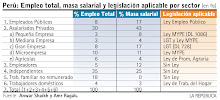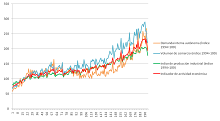Terence Poon | March 11, 2009 CHINA'S export and import levels fell sharply for the fourth consecutive month in February. A truck travels through the Yangshan Deepwater port in Shanghai, China. Picture: Bloomberg Exports fell by a wider margin than in January, government data showed today. "This is clearly worse than expected," said Robert Subbaraman, a Hong Kong-based analyst with Nomura International. Imports dropped 24.1 per cent to $US60.1 billion, data from the General Administration of Customs showed. Still, there were signs that Beijing's 4 trillion yuan ($925 billion) stimulus program was being felt, as fixed-asset investment (FAI) in China's urban areas rose more than expected in the January-February period on a spike in central government investment. Additional reporting: AFP
February's exports fell 25.7 per cent from a year earlier to $US64.9 billion ($100.5 billion).
The decline in exports steepened from January's 17.5 per cent fall, while the dive in imports actually eased from January's 43.1 per cent drop.
China's trade surplus in February totalled $US4.84 billion, down from $US39.1 billion in January.
The median forecast of six economists in a Dow Jones Newswires survey was for a 6.7 per cent drop in exports, a 29.8 per cent fall in imports, and a trade surplus of $US29.5 billion in February.
In the January-February period, exports fell 21.1 per cent from a year earlier, while imports dropped 34.2 per cent. The trade surplus for the period totalled $US43.89 billion.
The National Bureau of Statistics said urban FAI jumped 26.5 per cent to 1.028 trillion yuan in the first two months of this year, compared with the same period last year, outstripping last year's 26.1 per cent rise and well above the median 19.8 per cent increase that had been forecast by five economists surveyed earlier by Dow Jones Newswires.
Investment in central government projects soared 40.3 per cent to 107.0 billion yuan in January-February, compared with a 29.6 per cent increase for all of 2008.
Investment in local government projects jumped 25.1 per cent to 920.6 billion yuan for the same period, compared with a 25.7 per cent increase for all of last year.
The January-February data, which wasn't broken down for the individual months, is the first indication of the trend for domestic investment this year since Beijing launched its stimulus program in November; it will run through 2010.
A Goldman Sachs economists' report said: "Being aware of the policy-lag issue, the Government requested firms that received direct government stimulus funding to spend it as soon as possible, which is consistent with the rebound in the sales volume reported by capital goods producers in recent weeks."
It said the Government's stimulus measures should show a "significant impact" on FAI growth more in the second quarter.
Change settings via the Web (Yahoo! ID required)
Change settings via email: Switch delivery to Daily Digest | Switch format to Traditional
Visit Your Group | Yahoo! Groups Terms of Use | Unsubscribe
--
http://www.betaggarcian.blogspot.com/







